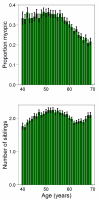Role of Educational Exposure in the Association Between Myopia and Birth Order
- PMID: 26448589
- PMCID: PMC4681114
- DOI: 10.1001/jamaophthalmol.2015.3556
Role of Educational Exposure in the Association Between Myopia and Birth Order
Abstract
Importance: Visual impairment due to myopia is an important public health issue. A prior analysis of population-based cohorts aged 15 to 22 years recruited from the United Kingdom and Israel suggested myopia and high myopia were approximately 10% more common in first-born compared with later-born children.
Objective: To examine whether myopia was associated with birth order in an earlier generation than studied previously and, if so, whether the association was attenuated after adjusting for education exposure, as predicted by the hypothesis that the education of children with later birth orders is less intense.
Design, setting, and participants: Cross-sectional study of UK Biobank participants recruited from 2006 to 2010. Analysis was restricted to participants aged 40 to 69 years who had a vision assessment, self-reported white ethnicity, and no history of eye disorders (N = 89,120). Myopia and high myopia were defined as autorefraction of -0.75 diopters (D) or less and -6.00 D or less, respectively.
Exposures: Birth order and information on potential confounders including highest educational qualification ascertained using a structured questionnaire.
Main outcomes and measures: Odds ratios (ORs) for myopia and high myopia by birth order, using logistic regression and adjusting for age and sex (model 1) or age, sex, and highest educational qualification (model 2).
Results: In model 1 (no adjustment for education), birth order was associated with both myopia and high myopia (eg, comparing first- vs second-born individuals; OR, 1.12; 95% CI, 1.08-1.16; P = 1.40E-11 and OR, 1.21; 95% CI, 1.11-1.30; P = 3.60E-06 for myopia and high myopia, respectively). The risk for myopia became progressively lower for later birth orders, suggesting a dose response. In model 2 (after adjusting for education), the effect sizes were attenuated by approximately 25% (OR, 1.09; 95% CI, 1.05-1.12; P = 1.30E-06 and OR, 1.15; 95% CI, 1.06-1.25; P = 4.60E-04 for myopia and high myopia, respectively) and the apparent dose response was abolished.
Conclusions and relevance: These data suggest that the association between birth order and myopia is not due to a new environmental pressure in the last 30 to 40 years. The attenuated effect size after adjusting for educational exposure supports a role for reduced parental investment in education of children with later birth orders in their relative protection from myopia.
Figures

References
-
- Morgan IG, Ohno-Matsui K, Saw SM. Myopia. Lancet. 2012;379(9827):1739–1748. - PubMed
Publication types
MeSH terms
Grants and funding
LinkOut - more resources
Full Text Sources
Other Literature Sources

